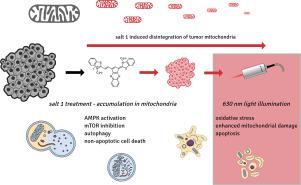Journal of Photochemistry and Photobiology B: Biology ( IF 5.4 ) Pub Date : 2020-06-23 , DOI: 10.1016/j.jphotobiol.2020.111939 Radovan Krejcir 1 , Tomas Briza 2 , Martin Sterba 1 , Oliver Simoncik 1 , Petr Muller 1 , Philip J Coates 1 , Pavel Martasek 3 , Borivoj Vojtesek 1 , Pavlina Zatloukalova 1

|
Despite progress in the development and application of novel therapeutic agents, cancer remains a major cause of death worldwide. Therefore, there is a need for new approaches to increase therapeutic options and efficiency. The metabolism of cancer cells differs from that of non-malignant cells and their mitochondria show altered activities that can be utilized as a target for drug development. Salt 1 is a low-molecular weight heterocyclic compound of the polymethine class that accumulates in the mitochondria of cancer cells and selectively disrupts their metabolism. Salt 1 leads to a non-apoptotic form of cell death in vitro that is associated with an autophagic cellular response and eventual metabolic collapse, and inhibits human tumor xenograft growth in vivo without apparent toxicity for normal cells. As a pentamethinium compound, salt 1 exhibits intrinsic fluorescence and is a candidate for photosensitization after excitation by appropriate wavelengths of light. Herein, we report that salt 1 is a potent photosensitizer, which generates a photodynamic effect and provides enhanced cytotoxicity compared to salt 1 without light exposure. Importantly, photosensitization is optimally induced by red light, which is used clinically for photosensitization and penetrates further into tissues than lower wavelengths. Cancer cells treated with non-cytotoxic doses of salt 1 and subsequently exposed to 630 nm light show severely damaged mitochondria, manifested by reduced mitochondrial membrane potential and disintegration of the mitochondrial tubular network. As a consequence, cancer cells lose their proliferative potential and die via apoptosis in the presence of light. These findings indicate that salt 1 is a promising photosensitizer with potential to be combined with 630 nm light to strengthen its efficacy in cancer therapy.
中文翻译:

抗癌五甲铵盐是一种有效的光敏剂,在红光照射下可诱导线粒体分解和凋亡。
尽管在新型治疗剂的开发和应用方面取得了进展,但是癌症仍然是全世界范围内主要的死亡原因。因此,需要增加治疗选择和效率的新方法。癌细胞的代谢不同于非恶性细胞,它们的线粒体显示出改变的活性,可以用作药物开发的靶标。盐1是聚次甲基类的低分子量杂环化合物,可在癌细胞的线粒体内积聚并有选择地破坏其代谢。盐1导致体外非凋亡形式的细胞死亡,这与自噬细胞反应和最终的代谢衰竭有关,并抑制人肿瘤异种移植物的生长体内对正常细胞无明显毒性。作为五甲亚锡化合物,盐1表现出固有的荧光性,并且是通过适当波长的光激发后光敏化的候选物。在此,我们报道盐1是一种有效的光敏剂,与没有光照的盐1相比,它可以产生光动力作用并提供增强的细胞毒性。重要的是,光敏作用是由红光最佳地诱导的,红光在临床上用于光敏作用,并且比低波长的光更能渗透到组织中。用无细胞毒性剂量的盐1处理的癌细胞随后暴露于630 nm的光线中,线粒体受到严重破坏,表现为线粒体膜电位降低和线粒体管状网络解体。结果,癌细胞在光的存在下失去了增殖能力并通过凋亡而死亡。这些发现表明,盐1是一种有前途的光敏剂,具有与630 nm光组合以增强其在癌症治疗中的功效的潜力。



























 京公网安备 11010802027423号
京公网安备 11010802027423号